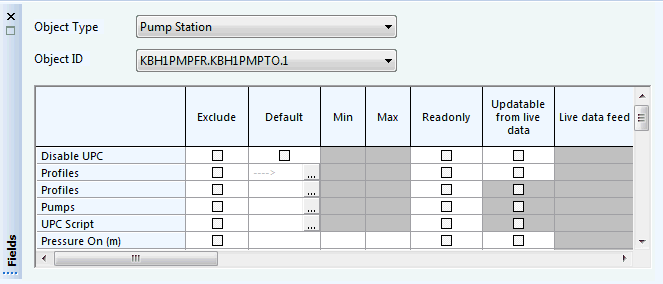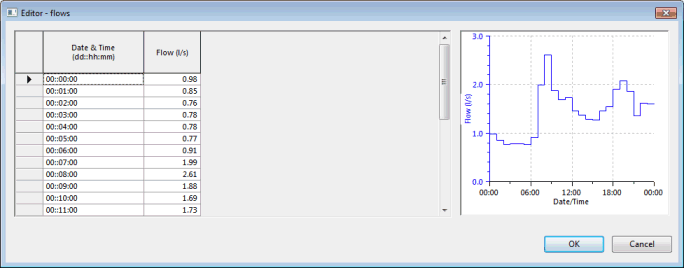The Fields window is used to specify changes to be made to controls in the network prior to running a simulation. Updates to demand scaling, demand patterns and electricity tariffs are also specified here.
Changes may be made by:
- updating from live data
- setting user specified values
- setting from previous projection runs (Water Quality only)
When a valid default simulation is set in the Default Model page, the Fields page is populated.
The fields present on the grid depend on the type of object selected and on the type of simulation implemented (normal, Water Quality, BalanceNet, etc).

For all object types but scaling demand, scaling demand (category by area), demand pattern and electricity tariff - Select an object using the Object Type and Object ID dropdown lists to display the settings for individual fields for that object.
|
Object Type |
Select the type of object to set updates for. This dropdown list contains all the available network object types, and entries for demand scaling, demand patterns and electricity tariffs. Demand scaling, demand patterns and electricity tariffs can be specified here using user-defined values or a link to a live data feed. |
||||||||||
|
Object ID |
Available to all object types with the exception of Demand Scaling, Scaling Demand (Category by Area), Demand Pattern and Electricity Tariff. Select the Object ID. |
||||||||||
| Area |
Available when Object Type is set to Demand Scaling (Category in Area) Select an area code. |
||||||||||
|
Tariff |
Available when Object Type is set to Electricity Tariff Select an electricity tariff. |
||||||||||
|
Radio buttons |
Available when Object Type is set to Demand Scaling.
Scaling Ratio - Select to display demand using scaling ratios. Adjusted Demand - Select to display demand in absolute values. Demand Category - Select to apply scale factors to demand grouped by demand category. Demand Area - Select to apply scale factors to demand grouped by area code. Note: Demand scaling values are reset whenever a different radio button is selected in order to maintain setting integrity. The user will be prompted for confirmation before values are actually reset. |
||||||||||
| Exclude |
Available for most object types (disabled for Demand Pattern, Demand Scaling and Electricity Tariff). Check this option to exclude this field from the Operator mode. It will not be possible to view or set this field from IWLive Pro Operator. |
||||||||||
| Default |
Value to be used when Mode of operation is set to Use default. These values are initially set from the control or parameter associated with the default simulation set in the Default Model page. A user defined value may be entered. If the field consists of a time varying profile e.g. Transfer Node flows or demand patterns, click the
|
||||||||||
| Min |
This field is disabled for non-numeric fields. Minimum allowable value for field initially set by InfoWorks WS Pro, however a user defined value may be entered. Behaviour is as follows if values fall outside of the allowable range:
(If Mode of operation set to Default, default values are always used.) |
||||||||||
| Max |
This field is disabled for non-numeric fields. Maximum allowable value for field initially set by InfoWorks WS Pro, however a user defined value may be entered. Behaviour is as follows if values fall outside of the allowable range:
(If Mode of operation set to Default, default values are always used.) |
||||||||||
| Readonly |
Available for most object types (disabled for Demand Pattern, Demand Scaling and Electricity Tariff). Check this option to prevent editing of the field in IWLive Pro Operator. |
||||||||||
| Updatable from live data |
Check this option to update the field from live data prior to running the simulation. |
||||||||||
| Live data feed 1 |
Dropdown list of Live Data Configuration objects specified in the Live Data Options page. Select the Live Data Configuration containing links to the telemetry point associated with the currently selected network object, demand scaling, demand pattern or electricity tariff. |
||||||||||
| Live data feed 2 |
Dropdown list of Live Data Configuration objects specified in the Live Data Options page. Select the Live Data Configuration containing links to the telemetry point associated with the currently selected network object, demand scaling, demand pattern or electricity tariff. |
||||||||||
|
Live data feeds |
Available for BalanceNet Volume Constraints only. Click the
|
||||||||||
| Mode of operation |
Defines the method to be used to update the field.
|
||||||||||
|
Demand pattern mode |
Define the demand pattern mode. There are four available options:
|
||||||||||
| Ignore validation limits |
Enabled when Mode of operation is set to Use override. Check this option to ignore values set in the Min and Max fields. |
||||||||||
| Override value |
Specify a value to be used when Mode of operation is set to Use override. If the field consists of a time varying profile e.g. Transfer Node flows, click the
Note: If an override value is below the Min value or above the Max value (see above), IWLive Pro will take the override into account but will clamp the value so it is within the allowable range. |
||||||||||
|
Forecast unit |
Enabled when Mode of operation is set to Forecast. Used in conjunction with Forecast value to specify a time offset for the telemetry data to be used. Specify the unit to be used (Days or weeks). |
||||||||||
|
Forecast value |
Enabled when Mode of operation is set to Forecast. Used in conjunction with Forecast unit to specify a time offset for the telemetry data to be used.
|
||||||||||
| DemandWatch |
Enabled when Object Type is set to Demand Scaling, and only for areas for which Updatable from live data has been enabled. Check this option to indicate that the specified live data feed originates from DemandWatch. See note below for further details. |
||||||||||
| DemandWatch Mode |
Enabled when Object Type is set to Demand Scaling (Category in Area), and only for categories used in areas for which Updatable from live data and DemandWatch have been enabled. Available options are:
Tip: This field will be disabled (greyed out) for categories that are irrelevant to the area selected in the Area dropdown list. I will also be automatically defaulted to None. |
||||||||||
| Setting delay |
Resetting to default values
All the values in a row can be reset to the default values of the corresponding control by selecting a row in the Fields grid and choosing the Reset row to default values option from the context menu.
Important Note about pump stations
Pump stations have an extra field called Pump Station Live Control. Pump Station Live Control is an array of control statements ordered by time that override any rules or controls (e.g. UPC settings) that may have been set up for the run.
The Live Control parameter is different from the other fields in that it allows users to change a value after time zero, as opposed to at initialisation time. Please note that you will need to enter a duration.
Refer to the InfoWorks WS Pro help for more information.
Important Note about DemandWatch integration
The integration with DemandWatch is performed in the Fields tab of the Baseline, by setting values for the Demand Scaling and Demand Scaling (Category by Area). object types.
Instructions are given below.
- Set the Object Type to Demand Scaling.
- Enable the Updatable from live data option for the desired areas.
- For each area:
- Specify a live data feed.
- Ensure Mode of Operation is set to Forecast.
- Ensure Forecast unit is set to Day(s) and Forecast Value to 0.
- Enable the DemandWatch option (tick the checkbox).
- Set the Object Type to Demand Scaling (Category by Area).
- Select the desired area in the Area dropdown list.
- Edit the DemandWatch Mode for the desired categories.
Important Note about BalanceNet runs
Edits to
BalanceNet constraints of pumping stations, meters and pipes is performed in the
Fields tab of the Baseline (or the Properties Window), by setting values in the
Flow Constraints Editor. To display the editor, click the
 button adjacent to the
BalanceNet Volume Constraints field
button adjacent to the
BalanceNet Volume Constraints field
Additionally it is possible to update BalanceNet volume constraints using Live Data. For this, the
Updatable from live data option must be enabled for the
BalanceNet Volume Constraints field and one or more live data feeds must be specified in the
Live Data Feeds Editor that get displayed when the
 button of the
Live Data Feeds column is clicked on.
button of the
Live Data Feeds column is clicked on.

 button to display a Profile
button to display a Profile

